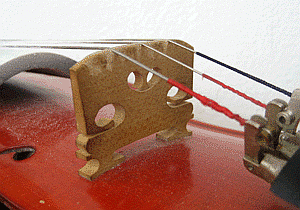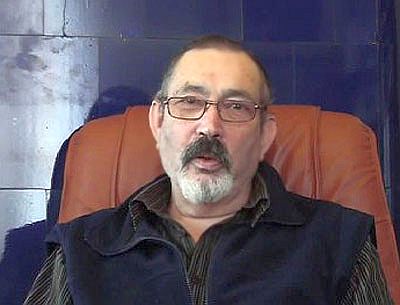 Teadus ja Kunst
Teadus ja KunstНаука и Искусство
Science and Arts
 Teadus ja Kunst
Teadus ja Kunst|
Accept my belated congratulations on your invention. The first question that crosses my mind: As far as I know, the violin has not changed for hundreds of years. How did an idea arise to add something, to make a change? For whom is it necessary? For what purpose? 
Regular viola
The modern violin was created by Andrea Amati in 1550. Since then it changed a little in spite of the fact that about 700 inventions were
registered (in a class of bow instruments). Bow instruments are designed for solo, i.e. they are not suitable for playing chords. At the same time,
there is a special group of chord instruments (keyboard, plucked) that allow to play solo or chords alternately (solo and accompaniment).

Brasca - three-stringed chord viola
Therefore, they modified a viola for this purpose, having made it a chord instrument. In the Gipsy-Hungarian tradition such instrument is called
"Bracha (bracsa)”.
So why didn't Gipsy musicians turn their bracsa into a two-mode instrument? Strangely enough, the reasons were not technical but social. The Gipsy community is deeply patriarchal and authoritative. A musical group is a social entity whose leader (as is typical for their community) doesn't allow other members of ensemble to be the soloist. For comparison, there is democracy in jazz. Everyone has the right to play solo… Why add the solo mode to bracsa if the musician would not be allowed to play solo… And still, how did you, all of a sudden, become engaged in all this and "to whom it is necessary"?
The idea arose when my acquaintance, the violinist Priyt Bernhardt, familiarized me with a chord viola (bracsa) and gave me his own viola
which has been already modified as bracsa. He showed me some introductory methods of playing this instrument, and I began to practice. Soon I
realized that I could try adding a solo register to its chord register. I started exploring the ways to do so.
Is your invention officially recognized, patented? Yes. There is a form of recognition of the invention. It is called "Utility model". Its protection is weaker than of a patent (10 years instead of 20), and it is valid only in Estonia. But what is important – the invention is worldwide, i.e. nobody and nowhere could receive a patent for this invention. For the entire history of the Estonian State our invention is the first and the only one in a class of bow instruments. I am not a technical expert. Tell me please, in a popular form, what is the essence of your invention? It is always difficult to explain in words any technical things. There are illustrations, the design. One problem is that if it is too simple and clear, there is a temptation to steal. After all this type of patent protection works only in Estonia...
Interesting. The obvious question: How come nobody had this idea before? Why is it you and why now, but not 40 years ago? I already spoke about the Gipsy musicians. The question about “why and now” is difficult. A lot of things happened by accident. Naturally, I am not a professional musician and I have no prejudice. For example, experts in aerodynamics tell us: "Flying, the dragonfly breaks laws of aerodynamics but why does it fly?" "Because it doesn't know these laws." My coauthor, the doctor of physics, says that our predecessors definitely tried, but it didn't work. We were not aware of that, and also we were lucky. As I understand, you had assistants and consultants? Who helped you with work? The total list includes about 50 names. There are three coauthors:
Also, I want to mention the violinist and the teacher, Mikhkel Kuusler, my violin and chord viola instructor who writes transcriptions for C/V. It is necessary to mention Mikhail Kazinik (a star of the Russian television in a genre of promoting of classical music). In 2012, being in Tallinn on a tour, he found time to listen to me and my instrument. He helped me very much having made the recommendations, and he opened for me doors to various musical institutions of Russia. Thanks to Kazinik's support, I was presented to the composer Shandor Kalosh who wrote the only existing work for accord viola, "Concerto Grosso Per Viola Gabriele solo". How do musicians, violinists treat your innovation? Whether there is a hope for broad application of your invention? As they say, what are your "creative plans"?
Strictly speaking, I don't know it. The majority (about 300 people) to whom I sent my article didn't answer (297). Those whom I informed personally
didn't react either. I can tell that there are people (colleagues) with whom I play music who help me in advancing my ideas.
Thank you, Gaby! Can you tell a little about yourself. Your ancestors have lived in Estonia for a long time? 
I was born in 1946 in Tallinn and was the youngest child (sister Rachel) in a family of Ber Passov (1917, Tallinn) and Blyuma Shapiro (1915, Narva).
The Etonian Passovs were natives of Belarus (Gorodock, a town inthe Vitebsk province). The great-grandfather Jacob moved to Valga in 1897, having got a
job on the Pskov/Riga railroad. In 1910 he moved to Tallinn. His younger daughter Zelma, having graduated, in 1934, from the Tarty University with degree
in natural sciences (with honors), taught chemistry and biology in the Jewish gymnasium. All I know about the family of my mother is that her parents
(Gabrielle Shapiro and Doba Shapiro (Aronovich)) moved from Lithuania to Narva at the beginning of the XX.
You can watch the Estonian TV program (in Estonian) about this invention here Gabi Passov's unternet site |